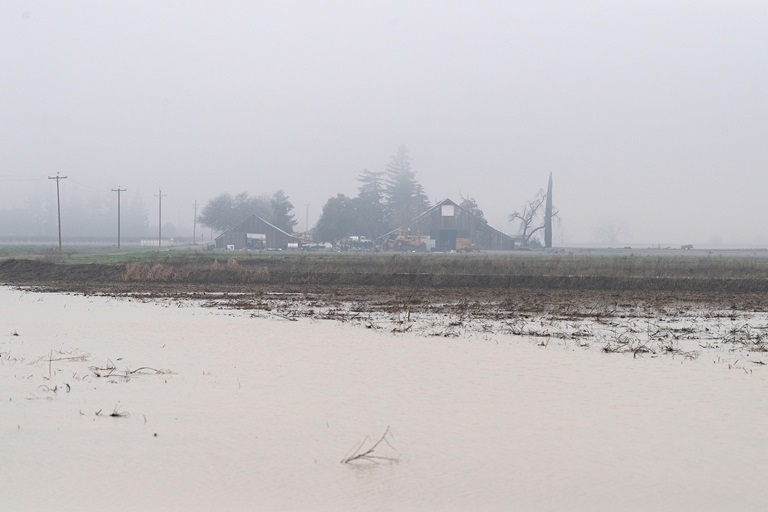Groundwater Recharge - Capturing Water from Storms to Replenish Stressed Groundwater Basins
Standing water is seen at this groundwater recharge FloodMAR site in the Dunnigan area of Yolo County. Photo taken January 18, 2023.
The wet winter storms in January 2023 have brought a lot of water that has the potential to be stored underground to replenish groundwater basins and help mitigate prolonged drought effects. Extended and extreme periods of drought driven by climate change have placed a high demand on groundwater resources, and the last three consecutive years of drought have led to declining groundwater levels throughout the state.
Groundwater is a critical component of California’s water storage, accounting for up to 60 percent of the state’s total water supply during dry conditions. During the recent series of storms across California, groundwater recharge is taking place naturally where water seeps into the ground, greatly benefiting our unseen aquifers.
Groundwater is heavily relied upon by communities, agriculture and the environment during dry years when there is less precipitation, while during normal and wet years, groundwater basins are replenished through groundwater recharge.
The state is committed to expediting groundwater recharge to maximize the capture of stormwater and the potential of the natural underground water storage capacity. Groundwater basins have the ability to hold 8 to 12 times more water than the state’s surface water storage and reservoirs. This is a key action in the Governor’s “Water Supply Strategy: Adapting to a Hotter, Drier Future” that was released in August 2022, outlining the necessary strategies to secure a more reliable water supply in the face of aridification and climate change.
Groundwater recharge can occur in two ways – through natural percolation of water into the land surface, which is occurring during these storms, or by diverting and conveying water to specific areas through managed recharge projects. Managed projects can capture water in rivers and streams at higher flows and move that water to various recharge facilities, such as open or agricultural lands to spread out and percolate into the ground, or specially designed percolation ponds. Groundwater Sustainability Agencies (GSA) throughout the state are planning a variety of groundwater recharge projects in their efforts to meet their long-term sustainability goals under the Sustainable Groundwater Management Act.
The process to divert and capture excess water for groundwater recharge requires planning, permits, infrastructure, and an understanding of the aquifer, underlying geology, and soil properties. These projects can provide multiple benefits including improving long-term groundwater sustainability, supporting environmental benefits, and capturing excess water during flood season to prepare for prolonged drought periods.
These projects need to be expedited and DWR is doing just that, in coordination with the State Water Resources Control Board (State Board), by conducting a pilot program to streamline regulatory approaches to accelerate groundwater recharge. In the first pilot study in Merced County, with the Merced Irrigation District and the Merced Irrigation-Urban GSA, DWR coordinated with the State Board to issue a temporary permit for the local agencies to coordinate the diversion of high flows from Mariposa Creek and store the water underground for later irrigation use. The State Board issued this temporary permit on January 6, in consultation with the California Department of Fish and Wildlife, who work to ensure environmental considerations are met. This Pilot Study is providing insight to the agencies to support further streamlining of the permitting process.
State Support for Local Groundwater Recharge Projects
The State is committed to increasing groundwater replenishment by 500,000 acre-feet of potential recharge capacity. DWR is investing $12 million in Prop. 68 funding to conduct helicopter surveys – called aerial electromagnetic (AEM) surveys – to scan the earth’s surface, like an MRI, to understand where the most suitable locations exist for groundwater recharge. All of the data and analyses from the AEM surveys are made publicly available, especially for local groundwater sustainability agencies who have proposed more than 340 groundwater recharge projects. DWR oversees local groundwater agencies in developing groundwater sustainability plans and carrying out projects, such as groundwater recharge, over the next two decades to meet the requirements of the Sustainable Groundwater Management Act, which is to achieve local groundwater basin sustainability goals in 20 years.
DWR has already begun advancing these local projects through financial assistance. In 2021 and 2022, DWR awarded $68 million to 42 groundwater recharge projects that provide nearly 117,000 acre-feet of potential recharge capacity. DWR will award additional grants in 2023 based on available funding. So far, applications for this funding include 52 proposed groundwater recharge projects, totaling $211 million in cost. These projects, once vetted, permitted, and constructed, will increase the potential capacity of getting more water underground.
